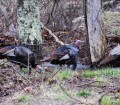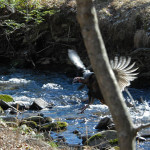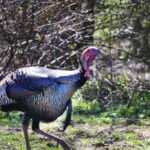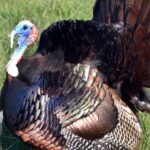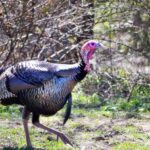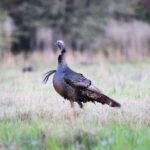John’s Note: Good positioning is a key factor for a successful turkey hunt, yet many hunters make five-common mistakes when setting up. Here’s how to avoid those errors.
The difference between killing a turkey and not killing a turkey is usually how, when and where you set the stage for action.
To be in the right place at the right time, you first must find a turkey to hunt. There are places a turkey enjoys 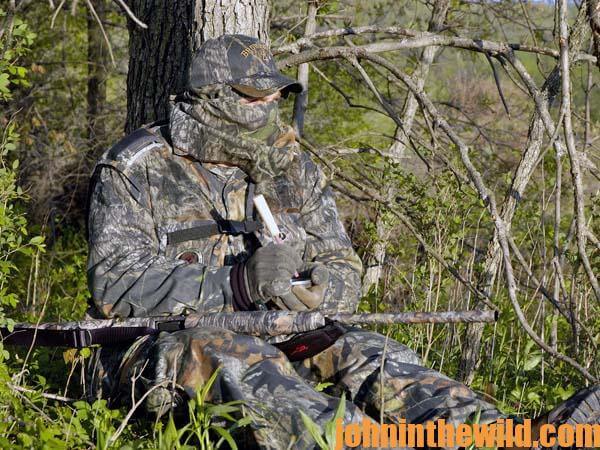 walking, including clean woods with little underbrush and fields where he can see for great distances. He’ll also walk on flat ground whenever possible. Too, a turkey follows a regular routine. He’s like an old man who goes by the barber shop at 8:15 am, stops at one of his regular stores to find-out if anyone’s sick, dead or just married, swings by the coffee shop to pick-up a newspaper and a sweet roll and then moves on to meet his friends for a game of dominoes. You can set your watch by that old man. Well, you also can set your watch by an ole gobbler in the spring. That bird has a set routine as predictable as the man down the street. Figure out that pattern, and you’ll probably bag the bird. He’ll roost in the same tree, fly-down in the same direction, try to mate in his strutting zones and feed in the same fields. Once you know the routine, then you need to plan the set up.
walking, including clean woods with little underbrush and fields where he can see for great distances. He’ll also walk on flat ground whenever possible. Too, a turkey follows a regular routine. He’s like an old man who goes by the barber shop at 8:15 am, stops at one of his regular stores to find-out if anyone’s sick, dead or just married, swings by the coffee shop to pick-up a newspaper and a sweet roll and then moves on to meet his friends for a game of dominoes. You can set your watch by that old man. Well, you also can set your watch by an ole gobbler in the spring. That bird has a set routine as predictable as the man down the street. Figure out that pattern, and you’ll probably bag the bird. He’ll roost in the same tree, fly-down in the same direction, try to mate in his strutting zones and feed in the same fields. Once you know the routine, then you need to plan the set up.
I get on a high hill where I can hear a long way off; then I use an owl call,” explains Dr. Toxey Dorsett, veteran turkey hunter from Birmingham, Alabama. “If a turkey doesn’t gobble within 15 minutes, I move to another listening spot. Hunting a non-gobbling turkey is almost impossible.” The late Buck Burns of Tuscaloosa, Ala., logged thousands of hours hunting turkeys. He believed that most novice hunters made their first mistake once they found a turkey. “Often these sportsmen will approach a turkey too closely when setting-up to call and end-up spooking the bird. If you set-up too far away, you always can move closer later on and still save the hunt. I’m convinced the best distance to set up at, depending on terrain, is from 100- to 200-yards from the turkey.”
Years ago I asked Burns to name the five mistakes most hunters made when setting-up on turkeys, and he gave information that still applies to turkey hunters today.
- “People often try calling a turkey to a place he just won’t go. For example, turkeys generally won’t cross water. So, avoid having water between you and the turkey. If you have to wade brooks, swim creeks or walk 2-miles out of the way to get around the water between you and the gobbler, do it! Your time will be better spent than trying to call the bird across the water. He just doesn’t want to get wet. A turkey doesn’t like to walk down hills either – yet some hunters will set-up to call a turkey down a hill and into a bottom. These hunters will fare better by moving up the ridge and onto the same plane with the bird. Turkeys are open-country critters. They
 sense danger in thick cover. But often new hunters will try calling a gobbler into or through a thicket where he naturally doesn’t want to go, so the hunter never sees a bird. Stay in open woods with your back up against a big tree, and try to be in front of the turkey as he goes about his business. The gobbler’s looking for a convenient hen – not one that will take him out of his way or into danger.
sense danger in thick cover. But often new hunters will try calling a gobbler into or through a thicket where he naturally doesn’t want to go, so the hunter never sees a bird. Stay in open woods with your back up against a big tree, and try to be in front of the turkey as he goes about his business. The gobbler’s looking for a convenient hen – not one that will take him out of his way or into danger. - “Most woodsmen know camouflage is critical to turkey-hunting success. But the wrong kind of camouflage can be as bad as no camouflage. I’ve seen hunters wearing head nets, full camo suits and dark boots that blend in well with the woods. These same hunters, though, have white or light-colored soles on their boots, and as soon as a turkey sees them, he’s gone. If you have white soles on your boots, be sure to cover them with leaves or buy another pair of boots. Early in the spring when the leaves are first budding, most outdoorsmen dress in green camo, although the woods are still brown at ground level. I’ve found that brown camo pants and a green top are best for early spring turkey hunting. I switch to wearing all green near the end of the season. The key is coordinating your camo with your surroundings. Remember you are matching wits with a turkey in his own living room, so you better match the décor. An old turkey hunter once told me, ‘A turkey believes that every hunter is a stump, and every stump is a hunter,’ and I think he’s right.”
John E. Phillips Kindle book “Turkey Hunting Tactics,” “Click here to get this book.”
About the Author
John Phillips, winner of the 2012 Homer Circle Fishing Award for outstanding fishing writer by the American Sportfishing Association (AMA) and the Professional Outdoor Media Association (POMA), the 2008 Crossbow Communicator of the year and the 2007 Legendary Communicator chosen for induction into the National Fresh Water Hall of Fame, is a freelance writer (over 6,000 magazine articles for about 100 magazines and several thousand newspaper columns published), magazine editor, photographer for print media as well as industry catalogues (over 25,000 photos published), lecturer, outdoor consultant, marketing consultant, book author and daily internet content provider with an overview of the outdoors.


